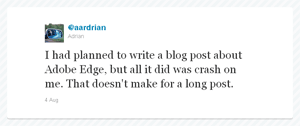More on HTML5 as DHTML
 Guns don’t kill people, the bullets do that (unless you pistol-whip someone to death, which means you probably ran out of bullets). Similarly HTML5, JavaScript, CSS and even Flash aren’t dangerous on their own, but in the wrong hands and with the wrong motives they can do harm.
Guns don’t kill people, the bullets do that (unless you pistol-whip someone to death, which means you probably ran out of bullets). Similarly HTML5, JavaScript, CSS and even Flash aren’t dangerous on their own, but in the wrong hands and with the wrong motives they can do harm.
I wrote a post almost a couple weeks ago, Don’t Let HTML5 Become the New DHTML, where I compared HTML5 with DHTML. I think it is an apt analogy still. Since then I have seen what I think is a spike in posts from people decrying poor development practices, ultimately resulting in whiz-bang sites that claim to be HTML5 but are really just platforms to demonstrate cool features for reasons that have no merit beyond “cool factor.”
I have a theory on why there is a recent uptick in this general theme — Adobe released Edge, its tool to help enable HTML5 / CSS3 / JavaScript animation-style development and (wrongly) considered to be a replacement for Flash. As people downloaded it and played around with it, a trend started to emerge. People were looking at the code Edge generated and realizing it was all just div soup (Why has Edge gone with div-based animation over canvas and SVG?). I am one of the many people who downloaded and installed this pre-beta so that I could see what it produced. I was not so lucky to get it working:
I suspect once people saw this code, from software which otherwise is not production-ready (or beta-ready, as Adobe claims), the ideas of HTML5 as a Flash killer coupled with its tag soup output rolled through the heads of lots of people, and so began the posts. I have collected some here:
- Adobe Launches New HTML5 Design Tool, August 1, 2011.
- The Final days of Flash: Adobe releases public preview of Edge HTML5 editor, August 1, 2011.
- Devs respond to Adobe Edge, August 2, 2011.
- Reckless web development practices are encouraging idiots, August 2, 2011.
- Hello, Adobe Edge!, August 4, 2011.
- Primum non nocere, August 5, 2011.
- HTML5, hollow demos and forgetting the basics, August 5, 2011.
- Are CSS3 and HTML5 the “New Flash”? August 8, 2011.
I think comparing HTML5 to Flash is a mistake. They are not the same. Flash is and always has been a proprietary tool built to enable features otherwise unavailable in standard HTML, CSS and JavaScript development while offering a consistent experience for users.
DHTML, however, was just a fake-brand for HTML4, CSS2 and JavaScript. People now use HTML5 to refer to HTML5, CSS3 and JavaScript, along with some other standards-based technologies. I think the parallels are obvious.
Update: August 11, 2011
Web 2.0 was another one of those marketing terms which encapsulated different things to different people. Now its demise is predicted: The death of Web 2.0 is nigh….
DHTMLX is better name for bad implementation of HTML5, “Living standards”, “Working drafts” etc.One Comment
In my opinion the doctype shall be:
etc. and changed with each upgrade.

Leave a Comment or Response